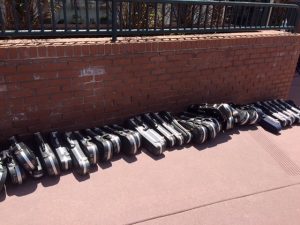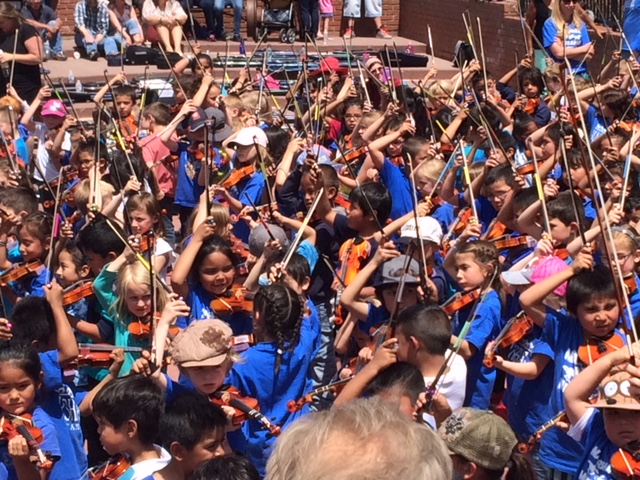By Heidi Toth
NAU Communications
Learning a musical instrument is a lot like learning a new language—the earlier a person starts, the easier it is.
Starting young is one of the concepts behind the Suzuki Method, a philosophy of learning music that allows the teaching and learning to happen naturally and in a fun, free environment. However, this philosophy has never been used quite like Karin Hallberg uses it.
Hallberg, a principal lecturer in violin/pedagogy at Northern Arizona University, is coordinator of the Suzuki String Program. Since 2001, she has taken the principles in the Suzuki method into Marshall Elementary School, a Title I school in Flagstaff, teaching hundreds of kindergarteners, first-graders and second-graders how to play the violin.
Next week, 300 of these students will perform a concert to show off their skills, walking over to Heritage Square from their school all wearing matching blue shirts and following their teachers like a row of ducklings.
“We get very excited about it,” said Hallberg with a laugh; this concert is the culmination of months of work with energetic youngsters with violins in their hands. “It’s very Flagstaff.”
Hallberg started with one class of kindergarteners and no set idea of how classes should go. The Suzuki method tends more toward one-on-one lessons, not one-on-25. She’s had to adapt, creating protocols to match the principles as she went.
As the years went by, she taught more students, took on more teachers and worked through various challenges, trying to create a protocol that could be applied to all the classes all the time and overcome the issues she faced while still effectively teaching violin to the students. Today, Kylie Ahern, an NAU alumna and teacher at the NAU Community Music and Dance Academy, graduate student Rachel Butherus and Leticia Velasco, all of whom are violinists with the Flagstaff Symphony, also teach with Hallberg.
After about a decade, she found the special sauce: a routine that allowed the children to fully participate, that kept them in unison as they prepared and then played and that minimized the amount of correcting and cajoling she and the other teachers had to do. The students learned when they heard a certain chord on the piano, it was time to be quiet; when a specific song began playing, they could pick up their violins and get them ready; when they started chanting “Statue of Liberty” it meant to hold their violins out before bringing the instruments to their chins. And then the students play: all together, all in tune, all in the right tempo.
“When they’re all playing together you feel really happy, even if it’s just the bunny song,” Ahern said.
Hallberg found a way around students talking out of turn by having them talking together as they prepared to play. She kept their hands busy with the bow and instrument and their feet occupied by standing and “unzipping” their feet to make a V shape. Each year, a new group came in and they started over while continuing to work with the first- and second-graders.
The results of these lessons, which many students may not have had access to otherwise, either because their families couldn’t afford it or because they hadn’t been introduced to the violin or orchestral music, are noticeable. The teachers support it, Ahern said; they often work with the teachers to see if a student needs a little extra attention. During music lessons, some of the instruction includes how to sit quietly and listen, how to not be the loudest in the group (not a good idea for an orchestra) and how to be on stage and perform without getting nervous.
But the benefits run deeper than that. Hallberg did some research on a group of students a few years ago, measuring their attention and working memory before they started music classes and again after five weeks. Even with such a short period of time, the results were exciting.
“I had a statistically significant change in attention measures, and attention is correlated with academic achievement,” she said. “That was only 15 hours of training.”
She and Ahern are presenting this research at the Suzuki conference in May, and Hallberg was invited to present at a conference in Athens, Greece, in June. One of her research goals is to reproduce those results in a more rigorous study.
There aren’t data to support other conclusions, but Ahern and Hallberg both said they’ve seen the positive effects violin lessons have on the students. The students learn a lot of words, repeating them until they understand; they count; they sit quietly while others have the floor. Sometimes Hallberg will tell the students, “We’re going to play an E string. Who has an E in their names?” That allows them to talk about letters and learn to spell their names.
The classes also help students who are English language learners, since there is so much repetition of language. Hallberg remembered one student, a young boy from Thailand who knew little English and never spoke—in violin class or any other class. During violin lessons, she had the students do singing repetitions, and he never sang.

This program ends at second grade, but some students have continued. Hallberg said students who rented a violin would get two free lessons from the NAU Community Music and Dance Academy, and she worked with students who were interested in continuing on after second grade but couldn’t afford the regular rates.
“If they’re really interested, Kylie and I try to find some way to make it work because I really don’t want someone not to take lessons just because of money,” she said.
Most of the students don’t continue, at least not long-term, though they remember their music lessons; Hallberg occasionally meets an excited young person in the grocery store who took these violin lessons. A few students have actually become violinists, attending music camps, playing in school orchestras and taking regular lessons.
“To me it’s sort of like any new thing: if you want someone to get to know music and art, you’ve got to have them experience it, and the younger the better,” she said. “There’s a lot of research showing that kids’ academic success is very much shaped by their kindergarten teacher. That kindergarten experience has a lot to do with things.”
The concert, which is free and open to the public, takes place at noon Thursday at Heritage Square, 111 W. Birch Ave in downtown Flagstaff.



